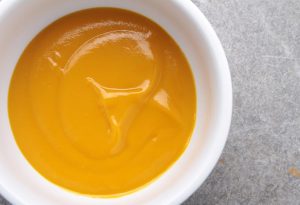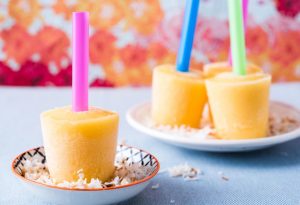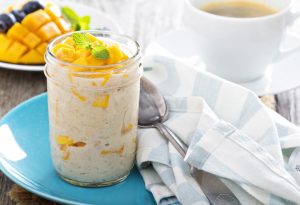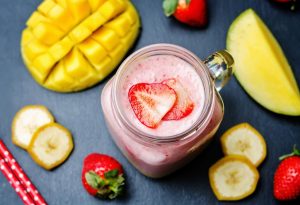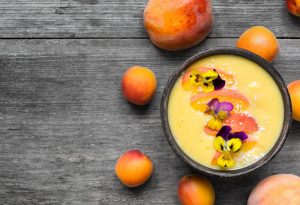In this Article
Mango is a great addition to your baby’s diet once they start on semi-solids or solids. Being seasonal, they offer a delicious alternative to foods your baby might have gotten bored of as well. They can even save you from a feeding time tantrum! Continue reading to know all about the goodness of mango and some yummy recipes you can whip up for your baby.
Are Mangoes Good for Your Baby?
Yes, they are! Mangoes are highly nutritious and needless to say, delicious. They are loaded with vitamins and minerals which nourish your growing baby. Mangoes are also a good source of natural sugars and carbohydrates which will keep your baby energized all day. Being a smooth soft fruit, they are also easy to feed individually or mix with other fruits in a puree.
When Can Mangoes Be Introduced to Babies?
8 to 10 months is the recommended age on an average to introduce mangoes to babies. Some offer mangoes as early as 6 months when their babies start on their first semi-solid foods. However, it’s best that you consult your paediatrician on when it’s best to feed mangoes and what types to choose from.
Nutrition Facts of Mango
Mangoes are packed with many essential nutrients that your baby needs. Here is a tab showing the nutritional value of mangoes.
| Nutrient | Value in every 100 g |
| Calories | 100 |
| Carbohydrates | 28 g |
| Fibre | 3 g |
| Protein | 0.8 g |
| Vitamin A | 0.378 mg |
| Folate | 23.1 ug |
| Vitamin B6 | 0.2 mg |
| Vitamin C | 46 mg |
| Vitamin E | 1.8 mg |
| Vitamin K | 6.9 ug |
| Copper | 0.2 mg |
| Potassium | 257 mg |
Source: https://draxe.com/mango-nutrition/
Health Benefits of Feeding Mango to a Baby
If you are wondering whether babies can have mangoes, go through all these benefits to know.
- Helps in digestion: Mangoes are rich in fibres and digestive enzymes, which means your baby will have an easy bowel movement and no risk of constipation. It lowers acidity in the digestive tract and helps in the breakdown of proteins.
- Good for the eyes: Mangoes contain plenty of Vitamin A, which is essential for good eyesight. It also helps maintain healthy eyes and avoid problems such as dryness, itching, refractive errors and night blindness. Just one small serving of mangoes can take care of a fourth of your baby’s Vitamin A needs for the day.
- Good for brain development: The glutamine acid, which is an amino acid present in mangoes, is essential for brain development. Along with Vitamin B6, it promotes better memory and brain functioning.
- Good for skin: Vitamin A, along with improving vision, is also good for the baby’s skin. It protects the skin while keeping it soft and glowing. Mango pulp applied to the skin also helps with complexion and moisturization.
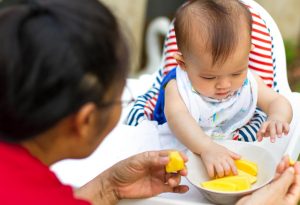
- Prevents risk of anaemia: Each mango contains about 0.5mg of iron which is needed for the production of red blood cells and also helps in preventing anaemia.
- Improves immunity: Mangoes have abundant Vitamin C which is much needed to strengthen the immune system. They also contain beta-carotene which is an antioxidant that further boosts immunity. Mangoes are also known to have a role in improving the epithelial function of the body which helps keep germs at bay.
- Helps in healthy weight gain: Mangoes are very low in fat but contain lots of good calories which can help your baby gain weight in a healthy manner.
- Prevents sunstrokes: The summer heat can dehydrate your baby and lead to sunstrokes especially when you take them outside. Mango juice is good to maintain hydration and electrolytes in the body.
Tips for Feeding Mango to a Baby
- It’s advisable not to feed mangoes to babies younger than 6 months old. It is suitable for babies that have already started on solids.
- Check for allergies. Feed the baby a small piece of mango on the first day and look for any allergic reaction. Wait a couple of days more before feeding them again. If you have a family history of allergy to mangoes, avoid feeding and consult the paediatrician.
- Mash the mango very well before feeding it to the baby. Ensure that there aren’t any solid clumps or visible fibres.
- Avoid mango varieties that are highly fibrous. Long fibres can lead to indigestion and diarrhoea. They are also hard to swallow and pose a choking hazard.
- Ensure that you feed the baby only ripe mangoes. Unripe mangoes that are sour can upset the baby’s stomach and lead to digestion problems.
Mango Allergy in Infants
Here are some allergies related to consumption of mangoes and what you can do about it.
- Mango being a tropical fruit tends to be allergenic to infants and hence, is not among the ideal first foods. Paediatricians suggest waiting for at least 8 months before you feed babies any tropical fruit.
- The allergic reactions to mangoes are rare and not serious. They generally appear on the skin, such as a rash around the mouth or bottom. The rashes resemble those caused by poison ivy.
- The allergen is normally on the mango’s skin and not on the inside. Allergies develop whenever the person comes in contact with the mango skin or sap. Allergies are seen mostly when the oleoresin from the peel comes in contact with the pulp of the fruit which is consumed.
- If your family has a history of allergies towards nuts or mangoes, consult the paediatrician before feeding it to your baby. You can also rub a little mango pulp on the baby’s skin and wait to see if a rash develops on the spot.
- Highly fibrous mango varieties should ideally be avoided. The little fibres can irritate the baby’s immature digestive tract and lead to diarrhoea.
- Always serve fresh mangoes to your baby once you’ve determined that they are not allergic to it. Avoid giving them mangoes that have been cut and stored for more than a day.
How to Choose and Store Mangoes?
To pick good mangoes for your baby, ensure that they are soft to touch and give off a nice aroma. These two are the qualities of a ripe mango. Second, look for signs of damage such as cuts, bruises, nicks or blemishes. Damage can set in a dent or rot in the fruit that is not visible on the outside or is sometimes an indication of worms inside. The skin should have a uniform reddish-yellow or orange-yellow tone with a few brown dots here and there. The fruit should be a little soft to squeeze and yet firm, and not puffy.
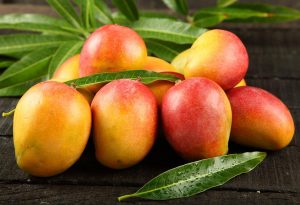
Ripe mangoes can be refrigerated for 4-5 days but do not store the unripe ones in the refrigerator. Unripe mangos are not as soft to touch and have a green-yellow skin. You can keep them in a closed paper bag and throw in a half-ripe mango with the bunch to help them ripe faster.
How to Prepare Baby Food with Mangoes?
Mangoes need to be washed thoroughly to rid them of chemicals and bacteria before you feed it to your baby. A mixture of water and vinegar in a 3:1 ratio should be first used to clean the mango. Then, rinse it thoroughly in running water and dry them. Cut the mango lengthwise on all sides around the seed. Scoop off the flesh from the skin and cut them into tiny cubes that can be had as finger food.
Mango Recipes for Babies
Now that you know all you need to introduce mangoes to your baby, here are some recipes that babies love.
1. Simple Mango Puree for Baby
The simplest way to feed mangoes to your baby, it has only one ingredient and no cooking involved.
Ingredients
- 1 ripe mango that is peeled and seed removed
How To Make
- Add mango pulp to the blender and puree it until it reaches a consistency your baby likes.
- You can also freeze some of that puree in an ice cube tray and serve it as a frozen dessert.
2. Teething-Soother Mango Popsicle
An easy-to-make popsicle which is a healthy and delicious way to soothe your baby’s teething pain. The cold dulls the pain and decreases inflammation while they chew on it.
Ingredients
- 1 ripe mango, chopped and peeled
- 2 ripe peaches, chopped and peeled
- 1 cup of yoghurt
How to make
- Add all the ingredients into a blender or a food processor.
- Blend them until they have a smooth, creamy texture.
- Pour the blended mixture into popsicle moulds.
- Freeze them overnight.
Based on how much your baby prefers to eat, you can half fill the moulds with the mixture. This makes for a great treat for adults too!
3. Mango Rice Pudding
A simple to make rice pudding combined with yummy tropical flavours.
Ingredients
- 1 mango – peeled and finely chopped
- 2 cups of coconut milk
- ¼ cup of brown rice
- ½ mashed banana
- ½ teaspoon vanilla extract
How to make
- Add the rice, milk, and vanilla extract into a saucepan and bring it to a boil.
- Let it simmer for about 25 minutes or until rice is soft. Stir the mixture regularly to stop it from sticking to the saucepan and add more coconut milk if necessary.
- Add the chopped mango and cook for 3 more minutes or until the rice is quite mushy.
- Turn off the heat and allow it to cool before stirring in the mashed banana.
- Serve warm or cool.
4. Mango-Strawberry Smoothie
A deliciously nourishing smoothie made out of a mix of mango, strawberry and avocados.
Ingredients
- ½ cup chopped mangoes
- 5 strawberries
- ½ avocado ( only the flesh)
How to make
- Add all the ingredients into a blender and puree until it’s smooth.
5. Mango Tango
This mix goes well with cereal, so it’s more suitable for babies who are slightly older.
Ingredients
- ½ cup of mashed mango
- 1 ripe peach, skinned, pitted, and mashed
- ½ ripe banana, peeled and mashed
How to make
- Add the ingredients to a bowl and mash together.
- If your baby prefers a thinner consistency, a little water and mash further.
- Serve the mixture as it is or with cereal.
FAQ’s
1. How is Mango Butter Beneficial for Babies?
Mango butter is made out of the seed extracts which are rich in fatty acids. It is beneficial as a skin cream for both moms and babies. Applying mango butter on the skin helps in protecting and nourishing the baby’s skin. It can also be used to soothe cradle cap and a diaper rash. Moms can also apply it on the skin as a moisturizer and use it on the belly to reduce stretch marks.
2. Are Dried Mangoes Safe for Babies?
Dried mango is a fun candy to chew on for babies. It can be also be given to ease the teething irritation of your baby. However, keep in mind that they can also be a choking hazard to infants, which is why it should be given in really tiny portions only. Also, make sure that you don’t give it to the baby regularly, as dried mangoes are infused with too much sugar which can harm your baby’s gums.
Mangoes are soft, tasty and highly nutritious which make them a perfect addition to your baby’s diet.



